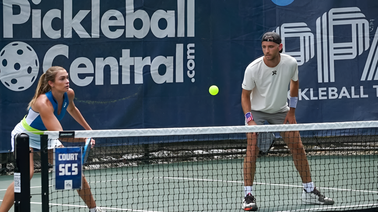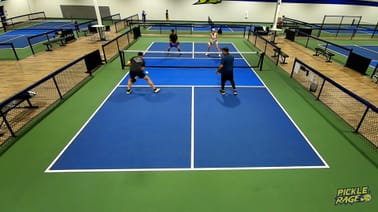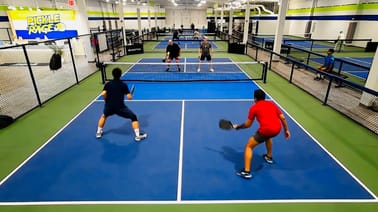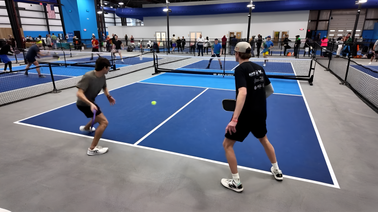
Getting smashed off the pickleball court can be fun, but when it happens between the 44 by 20…not so much. Yet we see it happening every day at every level of pickleball. The reason for all these smashes? Popups.
Of course, everyone, from time to time, is going to pop the ball up. It’s inevitable.
But if you find yourself consistently popping the ball up, maybe it’s because you don’t know what’s causing it, meaning you don’t know how to stop.
If you’re anything like us, you’ve even looked up at the heavens a time or two, begging the pickleball gods to help you stop getting your partner (or yourself) killed.
That’s where this article can help. It’s time to talk popups.
Why popups happen
While there are many reasons for popups, we’re going to focus on three of the main culprits:
- Reaching
- Bad Positioning
- Poor Shot Selection
Let’s discuss each in more detail and offer advice on improving.
Reaching
“You reach, I teach.” This mantra is preached at organized basketball camps across the country. It should probably be adopted by pickleball coaches as well.
Any time someone reaches for the ball in pickleball, there’s a greater chance of popping the ball up.
This happens because reaching causes you to hit up on the ball, strike the ball with the non-sweet spot of your paddle, or not get enough juice on your shot.
How to stop reaching
Anyone who has played organized sports understands how important footwork can be.
In every sport, you’re taught to have an athletic stance, get in front of (or behind) the ball, and don’t cross your feet–shuffle step instead. It’s the same for pickleball.
Improving your footwork can reduce the number of times you reach for the ball (we all have to reach sometimes, right?).
Good footwork means you are balanced, in control, and your elbows are tucked into your sides. Bad footwork means you should probably start wearing a face shield.
Tips for better footwork:
- Square your body up to the ball before you take a swing
- If you have time to take an extra step, you should probably take it–don’t be afraid to run around to your forehand
- Become a crab and practice your side-to-side shuffling at home
- Practice keeping your elbows in by placing a ball under your armpit while you warm up or drill
Bad positioning
Perhaps the cousin (or mean uncle) of terrible footwork is bad positioning. Your opponent is often trying to hit the ball where you aren’t.
If you’re giving up too much court on either side of you, then there’s a whole lot of “where you aren’t” real estate for them to aim. Next time you watch a pro match, pay attention to where they are standing, especially in comparison to their partner.
Rarely is there more than a few feet between them, and almost never is one way in front of the other (at least not for very long).
Some advice when playing doubles and thinking about positioning on the court is to pretend that there is a giant rubber band connecting you to your partner at the hip. If you let that rubber band get too taut, it will snap.
Also, read this article on how to Move With Your Partner.
Tips for better positioning:
- If your partner has to track down a ball along the sideline, you should cover the middle
- As you approach the kitchen, leave yourself with more forehand space than room behind your backhand
- Don’t think of the court as split in half–it’s okay to move across the middle line
- The closer you are to the kitchen, the fewer angles your opponents have to hit passing shots
Poor shot selection
Ever hit a shot that’s kind of a drop and kind of a lob because you couldn’t decide which you actually wanted to hit (or you changed your mind midswing)?
How’d that work out for you? We’re going to guess not so well.
It’s okay–we’ve all done it. Indecision or choosing the wrong shot at the wrong time can lead to some hairy situations on the pickleball court–including popups.
Pickleball action is fast, and you can’t exactly stop mid-point and mull over your different shot choices.
However, you can proactively think about different shots ahead of time and consider where you think the best spots might be when those situations arise.
Tips for better shot selection:
- Record your games and watch them back–ask yourself if you made the right choice and, if not, think about what you might do next time
- Talk pickleball strategy with your pickleball friends
- Watch videos and read blogs (like this one!) on strategy and improving your game
- Commit to the first shot that comes to mind–overcommitting to a bad shot in the moment will always be better than waffling between two different shots
- Stop trying to lob the ball from the baseline or in 20 mph winds
There you have it. Now, you’ll never pop the ball up again. Okay, maybe you will. But, hopefully not as much as you did before reading this article.









